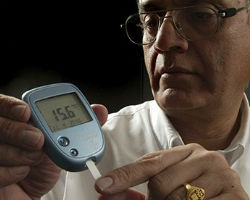Why does Diabetes Increase the Likelihood of Heart Disease?

Diabetes is major problem worldwide but especially in the United States. The number of people with diabetes is rapidly growing, although the rate at which this is happening has slightly decreased. The National Diabetes Statistics Report (released on June 10, 2024) has shown that the annual incidence of diabetes has decreased from 1.9 million of new diagnoses per year in 2010 to 1.7 million in 2012.
Nevertheless, the percentage of people affected by diabetes in the United States in 2012 was 9.3%, while the percentage of people with pre-diabetes was 27.5%. This is a huge number, considering how this condition damages a person’s health, even with the necessary treatment. Naturally, the circulatory system is one of the first things that is greatly damaged by elevated levels of sugar in the blood stream.
In this article we will discuss how this damage takes place and what happens as a result.
Glycation – the root of all problems
Glycation is the process of bonding proteins and lipids with sugar molecules, including glucose and fructose. This process is not enzyme controlled and is very detrimental to the human body. The latest studies have confirmed that fructose shows ten times the glycation activity of glucose (McPherson JD, Shilton BH, Walton DJ (March 1988). "Role of Fructose in Glycation and Cross-linking of Proteins"). Fructose is not as harmless as scientists previously thought.
Glycation induces the formation of advanced glycation end-products (AGEs), which are much more damaging than sugars themselves. AGEs are implicated in cardiovascular diseases (by damaging the collagen, fibrinogen and endothelium), Alzheimer’s disease (formation of amyloid), cancer (formation of acrylamide), peripheral neuropathy and sensory loss (as a result of demyelination).
High blood sugar, which is usually seen in untreated patients with diabetes, also causes the stiffening of collagen in the walls of the blood vessels. This prevents the blood vessels from stretching to react to the changes in blood volume, which causes blood pressure to rise, resulting in hypertension. Not only does glycation stiffen the collagen, it also causes it to weaken. This may result in micro- and macro-aneurisms (bulbous protrusions on the vessel walls), which can rupture and result in a stroke if they are located in the brain.
Moreover, advanced glycation end-products are responsible for initiating atherogenesis by triggering an inflammatory-proliferative process. The mechanisms by which AGEs promote atherosclerosis are still being researched. However, after scientists get a clearer understanding of these processes, a treatment will surely be manufactured to counteract the AGEs.
“Silent” heart disease
Due to the fact that advanced glycation end-products also damage the nerve endings through the process of demyelination, a person with heart disease might not notice any symptoms until it is too late. As a result, the condition of the patient may quickly deteriorate, since they might not turn to treatment in time.
This is especially dangerous if the person experiences a heart attack and does not realize it (this happens to about 30% of people with diabetes). How fast the person with a heart attack receives treatment is crucial for the outcome and the extent of the damage. If fibrinolytic agents are not administered in time, the area of necrosis (death of cells) will be much greater. Thus, people with diabetes should pay close attention to any strange feelings in their body, which include nausea, anxiety, lightheadedness, and sweating. Even people without diabetes often mistake a heart attack for food poisoning, losing precious time and worsening the outcome.
Conclusion
Scientists have yet to discover all the mechanisms responsible for increased risk of heart disease in people who have diabetes. But apparently, the main reason for this is the glycation process triggered by high concentrations of glucose within the bloodstream, which causes advanced glycation end-products to appear. New drugs aimed at preventing the consequences of diabetes might be aimed at counteracting or eliminating these advanced glycation end-products. However, none have been developed yet.
References:
1. National Diabetes Education Program: "I Have Diabetes."
2. American Diabetes Association: "Living With Diabetes."
3. National Diabetes Information Clearinghouse: "Diabetes, Heart Disease, and Stroke."









